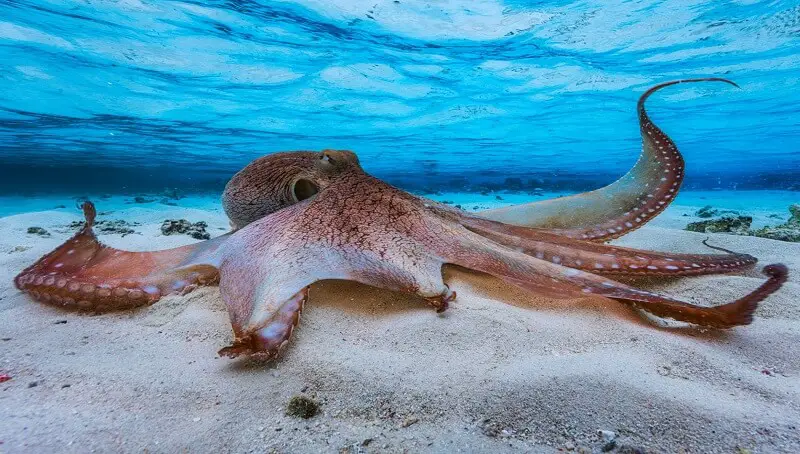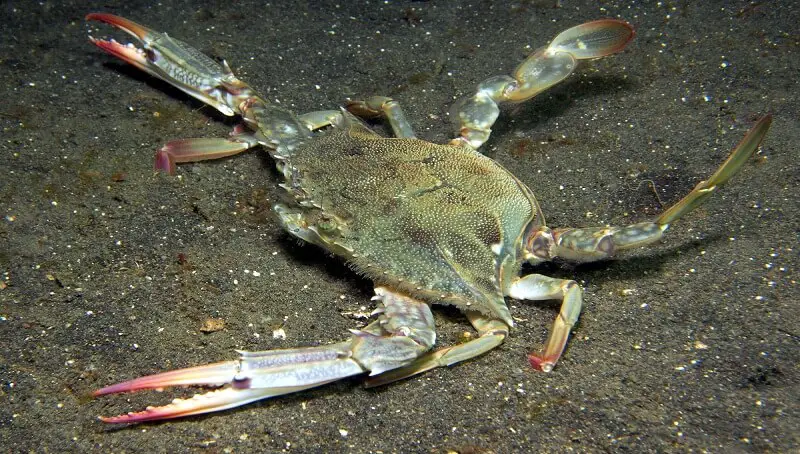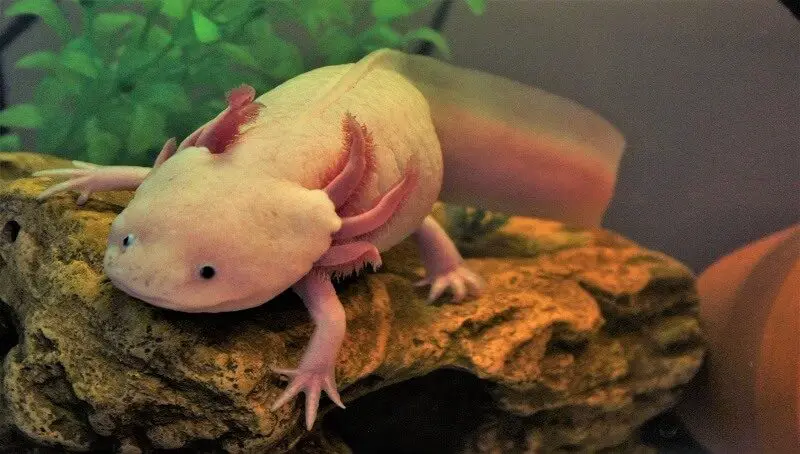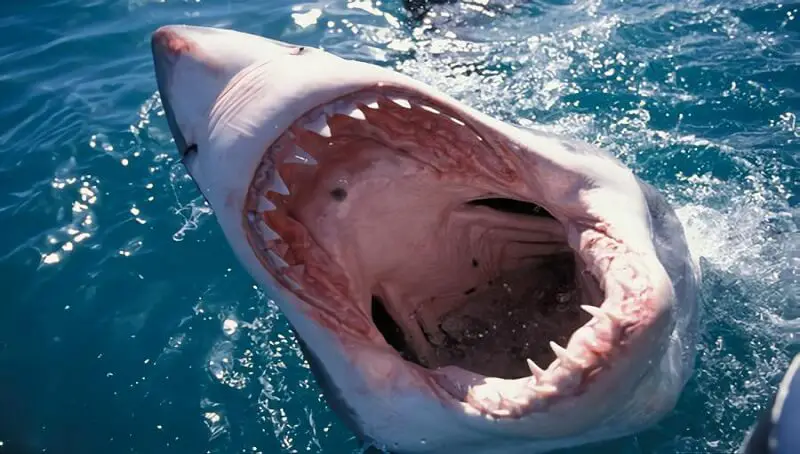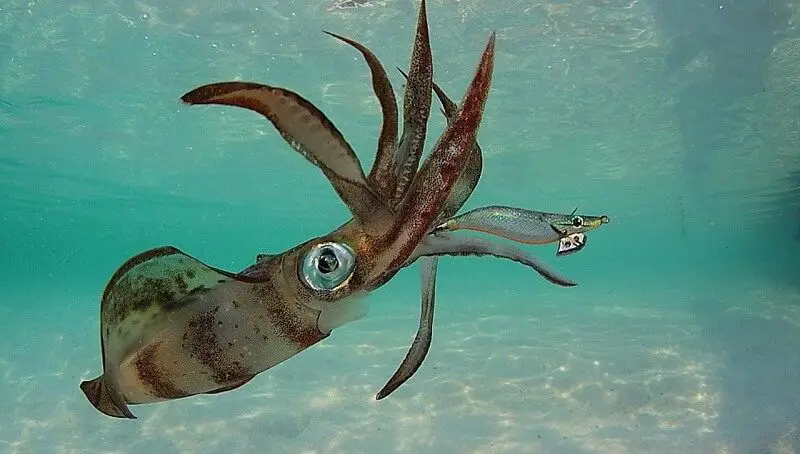The octopus is a cephalopod mollusk that is part of the order Octopoda. The octopus has two eyes and four pairs of arms.
Compared to the other cephalopods the arms of the octopus are arranged symmetrically bilaterally.
Its mouth is situated in the middle of the tentacles. Their body does not have a bone structure, and this allows them to pass through narrow places. The octopuses are by far the smartest invertebrates.
They can be found in various parts of the ocean, including coral reefs, among algae, or on the ocean bottom.
They have many strategies to defend themselves against predators: Ink spraying in water, camouflage, swimming quite fast, and the ability to hide.
All the octopuses are poisonous, but only one species is dangerous to man: The octopus with blue rings.
The octopuses are well known for the eight arms that have suckers (most species). They are used for locomotion and feeding.
Unlike the other cephalopods, the octopuses have soft flesh in the whole body and no skeleton. They have no external protection, such as shells, scales, sheathes, etc.
Lack of rigid masses allows them to slip through very narrow slots or between stones, which is very useful when they run away from predators.
They live in deep habitats as well as in coral reefs and shallower waters.
These animals have an extremely complex nervous system and only one part is located at the brain level. Two-thirds of the neurons are in their arms.
The tentacles have a series of complex reflexes that move independently with no connection to the brain. Unlike vertebrates, in the case of these creatures, it is believed that musculoskeletal movement is not commanded by the brain.
The common octopuses have a weight between 15 and 75 kg with arms over 4m in length. There are records with a specimen weighing 272 kg and having 9 m tentacles.
So Do Octopuses Have Bones?
The skin of an octopus contains cells with different pigments which, receiving a pulse from the central nervous system, begin to change and their mysterious regeneration occurs.
Do you need name ideas for octopuses? Here are 200 cool names for a pet octopus.
The whole body of the octopus flows easily from side to side, starting with the head and ending with eight tentacles with suckers. The body is very soft because the octopus has no bones.
This animal has the ability to change the shape of its body because there are no bones in its body structure. Some cephalopods may even use this ability to disguise, if necessary. These flexible creatures can sit in a very narrow, cramped place, the size of which is much smaller than the size of the octopus. They are able to hear a variety of sounds.
Each octopus sucker can weigh up to 100 grams. In order to hold an object on the tentacle, the marine animal must exercise sufficient muscle force.
Did Octopuses Ever Have Bones?
Although cephalopods are hard to follow back in time because they do not have skeletons, which means they cannot be identified as fossils, a recent study used DNA to try to discover their origins, which has proven to be a success.
The survey showed that the squid, the cuttlefish, and the octopus descend from a common ancestor that lived 160 million years ago
The oldest well-known octopus fossil was of an animal that lived about 296 million years ago during the fifth age of the Paleozoic.
How Do Octopuses Move Without Bones?
Another notable characteristic is the ability to change the shape of the body, due to the lack of bones.
For example, taking the form of a plateau, the octopus hides on the bottom of the sea, and it applies this strategy for both hunting and camouflage.
Also, the body’s moisture allows the giant octopus to squeeze through small holes, a few centimeters in diameter, and stay in a closed space whose volume is 1/4 of the animal’s size, without experiencing any inconvenience.
How Do Octopuses Keep Their Shape Without Bones?
Octopuses prefer to stay close to the bottom of the sea among algae and rocks. Octopus babies like hiding in empty shells.
During the day, they are less active, which means they are considered night-time animals.
On hard surfaces having any type of slope, the octopus can move easily thanks to its powerful tentacles.
Often, the octopuses use a swimming method where tentacles are not involved – they collect the water in the cavity behind the gills and move by pushing it with force. When it moves in this way, the tentacles end up behind the octopus. But, all swimming methods have a common disadvantage – the animal moves too slow.
While hunting, it is almost impossible for it to catch up with its prey, which is why the octopus prefers to hunt in an ambush.
The cephalopod goes hunting only at night. Its diet includes small crustaceans, various types of crabs, and a variety of fish. Using a camouflage technique, a sly octopus awaits the catch at the bottom of the sea, and when they approach, they attack. The octopus hugs its prey with all eight tentacles. After it bites the prey with the beak and it leaves a strong poison in it, the octopus offers its dinner a sure death. The internal structure of the octopus allows it to grind the paralyzed food easily.
Did you ever ask yourself if crabs can swim?
In the absence of a free crack in the habitat to arrange for a ‘house’, the octopus can go for anything else, the main condition is that the entrance is narrower and there is more free space inside.
But whatever the nest is, the animal keeps it in strict cleaning, removing the garbage from it with a targeted stream of water.
In case of danger, the octopuses seek to hide and hide immediately by releasing a small thread of ink behind them, which is produced by special glands.
The ink closes like a slowly rising stain which is gradually washed by water.
There is also a different thing used against enemies: If one of the tentacles is grabbed, the octopus can push it back with muscle effort. The removed tentacle will still be making involuntary movements for some time, distracting the enemy.
The octopuses experience cold weather at deep depths, returning to shallow water with the appearance of heat. They prefer an isolated life next to other octopuses of the same size.
Due to its high level of intelligence, the octopus can be tamed. In addition, it will recognize the person who feeds it from a group of people.
How Do Their Muscles Work Without a Skeletal Structure?
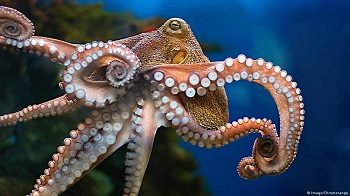 The tentacles of the octopus are extremely sensitive due to the huge number of taste buds on them.
The tentacles of the octopus are extremely sensitive due to the huge number of taste buds on them.
An adult can grow up to 4 meters long, while representatives of the smallest species, Argonauta argo, at maturity age will only grow up to 1 centimeter.
Therefore, depending on the type and length, the weight differs, and so, the largest representatives can weigh around 50 kilograms.
Almost any octopus can change its color, adapting to the environment and situation, because cells with different pigmentation are present in the skin, which contract and stretch at the command of the central nervous system. The standard color is brown, when scared it gets white, and red when is angry.
Octopuses are quite widespread – they are found in all tropical and subtropical seas and oceans, from relatively shallow waters to a depth of 150 meters. For permanent habitats, they choose rocky areas such as cracks and clams.
Do Octopuses Need Bones?
The main distinction that the octopus has from the squid and cuttlefish is that, as its name in English (octopus) suggests, it has eight tentacles, while the squid and cuttlefish have ten. The octopus is also much larger than the squid and cuttlefish and has growing tentacles.
The only one who has no shell is the octopus, which is another difference between an octopus, squid, and cuttlefish. The squid and the cuttlefish have an external “structure” to protect them. The lack of any type of hard structure makes the octopus more flexible.
What Are the Advantages of Not Having Bones for Octopuses?
They have a high speed of movement. In a period of danger, the body is able to accelerate to 16 km/h. They are able to move back because of the particularities of the body structure. The water enters the head in the form of a bag and is removed from it under pressure, moving it over long distances.
With a flexible, bone-free body, it can fit into the narrowest and most awkward places where a predator cannot reach.
The octopus is the only invertebrate that has proven that it can use tools.
Some species, such as the Mimic octopus, have a defensive system in addition to the rest of the octopuses: They take the form of other more dangerous marine mammals such as sea lions, sea snakes. They have an excellent touch-sensitive feel.
The best defense of an octopus is to hide, not be seen or detected. If the first defense failed, there are still a few more options.
The tentacles have a series of complex reflexes that move independently with no connection with the brain. Unlike vertebrates, in the case of octopuses, it is believed that musculoskeletal movement is not commanded by the brain.
Octopuses are perhaps the most amazing of all the deep-sea mollusks. Their strange appearance surprises, delights, sometimes even frightens. Human imagination created huge octopuses that can easily sink large ships. This type of demonization of the octopus has been greatly facilitated by the work of many famous writers. For example, Victor Hugo in his novel “The workers of the Sea” described the octopus as “the absolute embodiment of evil”. In reality, the octopuses, of which there are more than 200 species in nature, are completely harmless creatures and are more likely to be afraid of us, humans, and not the other way around.
